Spatiotemporal Relationship between Ecological Restoration Space and Ecosystem Services in the Yellow River Basin, China
Abstract
1. Introduction
2. Materials and Methods
2.1. Study Area
2.2. Data Processing
2.3. Methods
2.3.1. Trajectory Analysis to Map Ecological Restoration Space
2.3.2. Ecosystem Services Assessment and Mapping
- (1)
- Habitat quality
- (2)
- Carbon storage
- (3)
- Soil Conservation
2.3.3. Global-Spatial-Autocorrelation Analysis
2.3.4. Spatial-Response Characterization
3. Results
3.1. Spatiotemporal Pattern and Evolution of Ecological Restoration Space
3.2. Spatial Variation Characteristics of Ecosystem Services
3.3. Spatial Response of Ecosystem Services on Ecological Restoration Space
4. Discussion
4.1. Implications of the Obtained Results
- (1)
- Ecological restoration significantly improves ecosystem services. This type of area is the most powerful evidence of the positive impact of ecological restoration on ESs, and is more concentrated in the Loess Plateau. Considerable research has shown that the quality of the ecological environment in the Loess Plateau improved significantly due to ecological restoration [39,40,41].
- (2)
- Unobvious changes in ecosystem services accompany ecological restoration. Unfortunately, although large-scale ecological restoration had been carried out, the improvement trend in the environment in some regions was not apparent; in some cases, ecological degradation still occurred. We believe that although ecological restoration delays or hinders the trend in ecological degradation in ecologically fragile areas to some extent, its spatial quantity or time-series length is insufficient to reach the threshold of reversing degradation, that is, the lag effect of ERS on ESs. Although site-specific ecological-restoration activities, such as afforestation and grain for green, are being continuously implemented, it will be difficult and require a significant amount time to transform the structure of land properties and ecological functions due to the fragile nature of the region’s ecosystem. Intraspecific trade-offs in ESs may also be an important cause of this phenomenon [42]. Afforestation effectively reduces soil erosion and significantly enhances ESs such as SC and HQ, but deeper root systems of forest can utilize water stored in deeper soils under drought conditions [31], which significantly reduces water purification and causes trade-offs among ecosystem services in the region. In addition, the negative impacts of human activities such as overgrazing and reclamation also offset the positive effects of ecological restoration to a certain extent [20].
- (3)
- Obvious improvement in ecosystem services without ecological restoration. It should be noted where no ecological restoration activities were detected, but ESs tended to improve. The ecosystem quality in western Inner Mongolia and northwestern Qinghai improved significantly, but the cumulative area of ERS was tiny. From the perspective of time scale, ERS in western Inner Mongolia may have experienced a cycle of “degradation-restoration-redegradation” [43]. From a socioeconomic perspective, measures such as logging and grazing restrictions may lack necessary compensation for farmers and herdsmen, or the compensation amount provided may fall short of expectations. This has led to a negative impact on these projects, as some farmers and forestry workers have been dissuaded from participating in them, ultimately resulting in unsustainable ecological restoration activities [44]. From the natural perspective, the unsuccessful recruitment of dominant tree species in forests can trigger a process of vegetation succession, leading to the replacement of trees by understory species, and potentially even leading to desertification. Statistics showed that the survival rate of afforestation in arid and semi-arid regions of northern China since 1949 is only 15% [44], and the restoration of this unsustainable cycle was not recognized by our identification model. On the other hand, the weak basic foundation of ESs in the region had been greatly improved in phased and fragmented restoration activities, but the overall quality was still poor.
- (4)
- Ecosystem services continued to deteriorate without ecological restoration. This was roughly distributed in major urban agglomerations such as the Fenwei Plains and the middle and lower reaches of the YRB. With the continuous expansion of the urban built-up area, taking some provincial capitals in the middle and lower reaches of the YRB as examples, the construction land area of Zhengzhou City and Jinan City increased by 1179.90 km2 and 881.30 km2, respectively, from 1990 to 2019, and the land-use structure changed dramatically (Table S7), which led to the inevitable degradation and fragmentation of ecological land and damaged the complete material information flow process of the ecosystem. In addition, southern Inner Mongolia and the northern Loess Plateau also had some distribution. This part of the region belongs to ecologically fragile areas, which can lead to continued deterioration in the ecological environment when the value of ESs is insufficient to maintain the self-circulation of the system [45].
4.2. Suggestions for Ecological Restoration in the Yellow River Basin
4.3. Limitations and Future Work
5. Conclusions
- (1)
- During 1990–2015, the spatial distribution of ERS continued to expand. By 2015, the cumulative area of ERS reached 184,197.05 km2. Of the three ERS subcategories, GRS accounted for the largest area (73.14%), followed by FRS (26.08%) and SRS (0.78%). Afforestation was widely implemented in the Loess Plateau region, especially in Inner Mongolia, Qinghai, and Shaanxi provinces. The geographic centers of FRS, GRS, and SRS occurred in differential migration patterns, as FRS and GRS fluctuated from southwest to northeast, but the migration of SRS generally moved southwest.
- (2)
- The spatiotemporal heterogeneity of the three ESs at the regional and grid scales showed that HQ, CS, and SC experienced a significant increase during the past 30 years, but they all showed a downward trend in 2010. ERS modifies the land-use structure and information flow pattern of the ecosystem in the YRB, which has a significant effect on the different ecosystem services.
- (3)
- Our findings demonstrated that the distribution of ERS significantly improved the conditions of HQ, CS, and SC on 75.48%, 71.86%, and 56.75% of land across the YRB, respectively. Regional differentiation distribution of ERS can improve integrated ecosystem quality.
Supplementary Materials
Author Contributions
Funding
Institutional Review Board Statement
Informed Consent Statement
Data Availability Statement
Acknowledgments
Conflicts of Interest
References
- Millennium Ecosystem Assessment (Program) (Ed.) Ecosystems and Human Well-Being: Synthesis; Island Press: Washington, DC, USA, 2005; ISBN 978-1-59726-040-4. [Google Scholar]
- Sabine, B.R.; Mathieu, G.; Olivier, B.; Miska, L.; Carmen, C.; Gregoire, M.; Antoine, G. From White to Green: Snow Cover Loss and Increased Vegetation Productivity in the European Alps. Science 2022, 376, 1119–1122. [Google Scholar]
- Semenchuk, P.; Plutzar, C.; Kastner, T.; Matej, S.; Bidoglio, G.; Erb, K.-H.; Essl, F.; Haberl, H.; Wessely, J.; Krausmann, F.; et al. Relative Effects of Land Conversion and Land-Use Intensity on Terrestrial Vertebrate Diversity. Nat. Commun. 2022, 13, 615. [Google Scholar] [CrossRef] [PubMed]
- Xie, H.; Zhang, Y.; Wu, Z.; Lv, T. A Bibliometric Analysis on Land Degradation: Current Status, Development, and Future Directions. Land 2020, 9, 28. [Google Scholar] [CrossRef]
- United Nations. United Nations Decade on Ecosystem Restoration (2021–2030); United Nations: New York, NY, USA, 2019; Volume 19-03519, pp. 1–6. Available online: https://documents-dds-ny.un.org/doc/UNDOC/GEN/N19/060/16/PDF/N1906016.pdf?OpenElement. (accessed on 1 July 2022).
- Chen, C.; Park, T.; Wang, X.; Piao, S.; Xu, B.; Chaturvedi, R.K.; Fuchs, R.; Brovkin, V.; Ciais, P.; Fensholt, R.; et al. China and India Lead in Greening of the World through Land-Use Management. Nat. Sustain. 2019, 2, 122–129. [Google Scholar] [CrossRef] [PubMed]
- Hu, J.; Zhou, Q.; Cao, Q.; Hu, J. Effects of Ecological Restoration Measures on Vegetation and Soil Properties in Semi-Humid Sandy Land on the Southeast Qinghai-Tibetan Plateau, China. Glob. Ecol. Conserv. 2022, 33, e02000. [Google Scholar] [CrossRef]
- Huang, C.; Zhou, Z.; Peng, C.; Teng, M.; Wang, P. How Is Biodiversity Changing in Response to Ecological Restoration in Terrestrial Ecosystems? A Meta-Analysis in China. Sci. Total Environ. 2019, 650, 1–9. [Google Scholar] [CrossRef] [PubMed]
- Bastin, J.-F.; Finegold, Y.; Garcia, C.; Mollicone, D.; Rezende, M.; Routh, D.; Zohner, C.M.; Crowther, T.W. The Global Tree Restoration Potential. Science 2019, 364, 76–79. [Google Scholar] [CrossRef]
- Temperton, V.M.; Buchmann, N.; Buisson, E.; Durigan, G.; Kazmierczak, Ł.; Perring, M.P.; de Sá Dechoum, M.; Veldman, J.W.; Overbeck, G.E. Step Back from the Forest and Step up to the Bonn Challenge: How a Broad Ecological Perspective Can Promote Successful Landscape Restoration. Restor. Ecol. 2019, 27, 705–719. [Google Scholar] [CrossRef]
- Cao, S.; Chen, L.; Shankman, D.; Wang, C.; Wang, X.; Zhang, H. Excessive Reliance on Afforestation in China’s Arid and Semi-Arid Regions: Lessons in Ecological Restoration. Earth Sci. Rev. 2011, 104, 240–245. [Google Scholar] [CrossRef]
- Lyu, R.; Clarke, K.C.; Zhang, J.; Feng, J.; Jia, X.; Li, J. Dynamics of Spatial Relationships among Ecosystem Services and Their Determinants: Implications for Land Use System Reform in Northwestern China. Land Use Policy 2021, 102, 105231. [Google Scholar] [CrossRef]
- Wheeler, B.W.; Lovell, R.; Higgins, S.L.; White, M.P.; Alcock, I.; Osborne, N.J.; Husk, K.; Sabel, C.E.; Depledge, M.H. Beyond Greenspace: An Ecological Study of Population General Health and Indicators of Natural Environment Type and Quality. Int. J. Health Geogr. 2015, 14, 17. [Google Scholar] [CrossRef] [PubMed]
- Lian, J.J.; Chen, H.S.; Wang, F.; Nie, Y.P.; Wang, K.L. Separating the Relative Contributions of Climate Change and Ecological Restoration to Runoff Change in a Mesoscale Karst Basin. Catena 2020, 194, 104705. [Google Scholar] [CrossRef]
- Yang, H.F.; Mu, S.J.; Li, J.L. Effects of Ecological Restoration Projects on Land Use and Land Cover Change and Its Influences on Territorial NPP in Xinjiang, China. Catena 2014, 115, 85–95. [Google Scholar] [CrossRef]
- Ding, Z.; Liu, Y.; Wang, L.C.; Chen, Y.A.; Yu, P.J.; Ma, M.G.; Tang, X.G. Effects and Implications of Ecological Restoration Projects on Ecosystem Water Use Efficiency in the Karst Region of Southwest China. Ecol. Eng. 2021, 170, 106356. [Google Scholar] [CrossRef]
- Yang, G.; Li, Y.; Huang, T.Q.; Fu, B.L.; Tang, J.; Zhang, X.; Wu, J.S. Multi-Scale Evaluation of Ecological Restoration Effects in the Riparian Zone Using Landsat Series Images from 1980 to 2019. Ecol. Indic. 2021, 132, 108342. [Google Scholar] [CrossRef]
- Zhai, T.; Huang, L. Linking MSPA and Circuit Theory to Identify the Spatial Range of Ecological Networks and Its Priority Areas for Conservation and Restoration in Urban Agglomeration. Front. Ecol. Evol. 2022, 10, 1–16. [Google Scholar] [CrossRef]
- Costanza, R.; d’Arge, R.; de Groot, R.; Farber, S.; Grasso, M.; Hannon, B.; Limburg, K.; Naeem, S.; O’Neill, R.V.; Paruelo, J.; et al. The Value of the World’s Ecosystem Services and Natural Capital. Nature 1997, 387, 253–260. [Google Scholar] [CrossRef]
- Jiang, C.; Wang, F.; Zhang, H.; Dong, X. Quantifying Changes in Multiple Ecosystem Services during 2000–2012 on the Loess Plateau, China, as a Result of Climate Variability and Ecological Restoration. Ecol. Eng. 2016, 97, 258–271. [Google Scholar] [CrossRef]
- Wang, Y.; Li, B. Dynamics Arising from the Impact of Large-scale Afforestation on Ecosystem Services. Land Degrad. Dev. 2022, 33, 3186–3198. [Google Scholar] [CrossRef]
- Wen, X.; Théau, J. Spatiotemporal Analysis of Water-Related Ecosystem Services under Ecological Restoration Scenarios: A Case Study in Northern Shaanxi, China. Sci. Total Environ. 2020, 720, 137477. [Google Scholar] [CrossRef]
- Chen, X.; Yu, L.; Du, Z.; Xu, Y.; Zhao, J.; Zhao, H.; Zhang, G.; Peng, D.; Gong, P. Distribution of Ecological Restoration Projects Associated with Land Use and Land Cover Change in China and Their Ecological Impacts. Sci. Total Environ. 2022, 825, 153938. [Google Scholar] [CrossRef]
- Li, Q.; Shi, X.Y.; Wu, Q.Q. Effects of Protection and Restoration on Reducing Ecological Vulnerability. Sci. Total Environ. 2021, 761, 143180. [Google Scholar] [CrossRef]
- Lu, F.; Hu, H.F.; Sun, W.J.; Zhu, J.J.; Liu, G.B.; Zhou, W.M.; Zhang, Q.F.; Shi, P.L.; Liu, X.P.; Wu, X.; et al. Effects of National Ecological Restoration Projects on Carbon Sequestration in China from 2001 to 2010. Proc. Natl. Acad. Sci. USA 2018, 115, 4039–4044. [Google Scholar] [CrossRef] [PubMed]
- Jiang, W.G.; Yuan, L.H.; Wang, W.J.; Cao, R.; Zhang, Y.F.; Shen, W.M. Spatio-Temporal Analysis of Vegetation Variation in the Yellow River Basin. Ecol. Indic. 2015, 51, 117–126. [Google Scholar] [CrossRef]
- Yang, J.; Huang, X. The 30 m Annual Land Cover Dataset and Its Dynamics in China from 1990 to 2019. Earth Syst. Sci. Data 2021, 13, 3907–3925. [Google Scholar] [CrossRef]
- Peng, J.; Zhao, M.; Guo, X.; Pan, Y.; Liu, Y. Spatial-Temporal Dynamics and Associated Driving Forces of Urban Ecological Land: A Case Study in Shenzhen City, China. Habitat Int. 2017, 60, 81–90. [Google Scholar] [CrossRef]
- Du, Z.R.; Yang, J.Y.; Ou, C.; Zhang, T.T. Agricultural Land Abandonment and Retirement Mapping in the Northern China Crop-Pasture Band Using Temporal Consistency Check and Trajectory-Based Change Detection Approach. IEEE Trans. Geosci. Remote Sens. 2022, 60, 1–12. [Google Scholar] [CrossRef]
- Song, X.P. Global Estimates of Ecosystem Service Value and Change: Taking Into Account Uncertainties in Satellite-Based Land Cover Data. Ecol. Econ. 2018, 143, 227–235. [Google Scholar] [CrossRef]
- Chang, X.; Xing, Y.; Wang, J.; Yang, H.; Gong, W. Effects of Land Use and Cover Change (LUCC) on Terrestrial Carbon Stocks in China between 2000 and 2018. Resour. Conserv. Recycl. 2022, 182, 106333. [Google Scholar] [CrossRef]
- Zhang, Y.; Liu, Y.; Zhang, Y.; Liu, Y.; Zhang, G.; Chen, Y. On the Spatial Relationship between Ecosystem Services and Urbanization: A Case Study in Wuhan, China. Sci. Total Environ. 2018, 637–638, 780–790. [Google Scholar] [CrossRef]
- Williams, J.R.; Arnold, J.G. A System of Erosion-Sediment Yield Models. Soil Technol. 1997, 11, 43–55. [Google Scholar] [CrossRef]
- Liu, Q.; Wu, Y.; Zhou, Y.; Li, X.; Yang, S.; Chen, Y.; Qu, Y.; Ma, J. A Novel Method to Analyze the Spatial Distribution and Potential Sources of Pollutant Combinations in the Soil of Beijing Urban Parks. Environ. Pollut. 2021, 284, 117191. [Google Scholar] [CrossRef] [PubMed]
- Liu, C.; Wu, X.; Wang, L. Analysis on Land Ecological Security Change and Affect Factors Using RS and GWR in the Danjiangkou Reservoir Area, China. Appl. Geogr. 2019, 105, 1–14. [Google Scholar] [CrossRef]
- Wu, R.; Zhang, J.; Bao, Y.; Tong, S. Using a Geographically Weighted Regression Model to Explore the Influencing Factors of CO2 Emissions from Energy Consumption in the Industrial Sector. Pol. J. Environ. Stud. 2016, 25, 2641–2652. [Google Scholar] [CrossRef]
- Wang, S.; Liu, Z.; Chen, Y.; Fang, C. Factors Influencing Ecosystem Services in the Pearl River Delta, China: Spatiotemporal Differentiation and Varying Importance. Resour. Conserv. Recycl. 2021, 168, 105477. [Google Scholar] [CrossRef]
- Pineda Jaimes, N.B.; Bosque Sendra, J.; Gómez Delgado, M.; Franco Plata, R. Exploring the Driving Forces behind Deforestation in the State of Mexico (Mexico) Using Geographically Weighted Regression. Appl. Geogr. 2010, 30, 576–591. [Google Scholar] [CrossRef]
- Dang, X.; Liu, G. Emergy Measures of Carrying Capacity and Sustainability of a Target Region for an Ecological Restoration Programme: A Case Study in Loess Hilly Region, China. J. Environ. Manag. 2012, 102, 55–64. [Google Scholar] [CrossRef]
- He, J.; Shi, X.; Fu, Y. Identifying Vegetation Restoration Effectiveness and Driving Factors on Different Micro-Topographic Types of Hilly Loess Plateau: From the Perspective of Ecological Resilience. J. Environ. Manag. 2021, 289, 112562. [Google Scholar] [CrossRef]
- Lü, Y.; Fu, B.; Feng, X.; Zeng, Y.; Liu, Y.; Chang, R.; Sun, G.; Wu, B. A Policy-Driven Large Scale Ecological Restoration: Quantifying Ecosystem Services Changes in the Loess Plateau of China. PLoS ONE 2012, 7, e31782. [Google Scholar] [CrossRef]
- Feng, Q.; Zhao, W.; Hu, X.; Liu, Y.; Daryanto, S.; Cherubini, F. Trading-off Ecosystem Services for Better Ecological Restoration: A Case Study in the Loess Plateau of China. J. Clean. Prod. 2020, 257, 120469. [Google Scholar] [CrossRef]
- Feng, R.; Wang, F.; Wang, K. Spatial-Temporal Patterns and Influencing Factors of Ecological Land Degradation-Restoration in Guangdong-Hong Kong-Macao Greater Bay Area. Sci. Total Environ. 2021, 794, 148671. [Google Scholar] [CrossRef]
- Cao, S. Why Large-Scale Afforestation Efforts in China Have Failed To Solve the Desertification Problem. Environ. Sci. Technol. 2008, 42, 1826–1831. [Google Scholar] [CrossRef] [PubMed]
- Wang, X.; Ma, X.; Feng, X.; Zhou, C.; Fu, B. Spatial-Temporal Characteristics of Trade-off and Synergy of Ecosystem Services in Key Vulnerable Ecological Areas in China. Shengtai Xuebao 2019, 39, 7344–7355. [Google Scholar] [CrossRef]
- Wang, Y.; Wang, H.; Liu, G.; Zhang, J.; Fang, Z. Factors Driving Water Yield Ecosystem Services in the Yellow River Economic Belt, China: Spatial Heterogeneity and Spatial Spillover Perspectives. J. Environ. Manag. 2022, 317, 115477. [Google Scholar] [CrossRef]
- Yang, J.; Xie, B.; Zhang, D.; Tao, W. Climate and Land Use Change Impacts on Water Yield Ecosystem Service in the Yellow River Basin, China. Environ. Earth Sci. 2021, 80, 1–12. [Google Scholar] [CrossRef]
- Liu, Y.; Li, J.; Yang, Y. Strategic Adjustment of Land Use Policy under the Economic Transformation. Land Use Policy 2018, 74, 5–14. [Google Scholar] [CrossRef]
- Bonilla-Bedoya, S.; Mora, A.; Vaca, A.; Estrella, A.; Herrera, M.Á. Modelling the Relationship between Urban Expansion Processes and Urban Forest Characteristics: An Application to the Metropolitan District of Quito. Comput. Environ. Urban Syst. 2020, 79, 101420. [Google Scholar] [CrossRef]
- Crossman, N.D.; Bernard, F.; Egoh, B.; Kalaba, F.; Lee, N.; Moolenaar, S. The Role of Ecological Restoration and Rehabilitation in Production Landscapes: An Enhanced Approach to Sustainable Development. In Working Paper for the UNCCD Global Land Outlook; United Nations: New York, NY, USA, 2017. [Google Scholar]
- Hu, Z.; Long, J.; Wang, X. Self-Healing, Natural Restoration and Artificail Restoration of Ecoligical Environment Foe Coal Mining. J. China Coal Soc. 2014, 59, 1751–1757. (In Chinese) [Google Scholar]
- Li, X.S.; Wang, H.Y.; Zhou, S.F.; Sun, B.; Gao, Z.H. Did Ecological Engineering Projects Have a Significant Effect on Large-Scale Vegetation Restoration in Beijing-Tianjin Sand Source Region, China? A Remote Sensing Approach. Chin. Geogr. Sci. 2016, 26, 216–228. [Google Scholar] [CrossRef]
- Crawford, C.; Yin, H.; Radeloff, V.; Wilcove, D. Rural Land Abandonment Is Too Ephemeral to Provide Major Benefits for Biodiversity and Climate. Sci. Adv. 2022, 8, eabm8999. [Google Scholar]
- Cao, S.; Zheng, X.; Chen, L.; Ma, H.; Xia, J. Using the Green Purchase Method to Help Farmers Escape the Poverty Trap in Semiarid China. Agron. Sustain. Dev. 2017, 37, 7. [Google Scholar] [CrossRef]
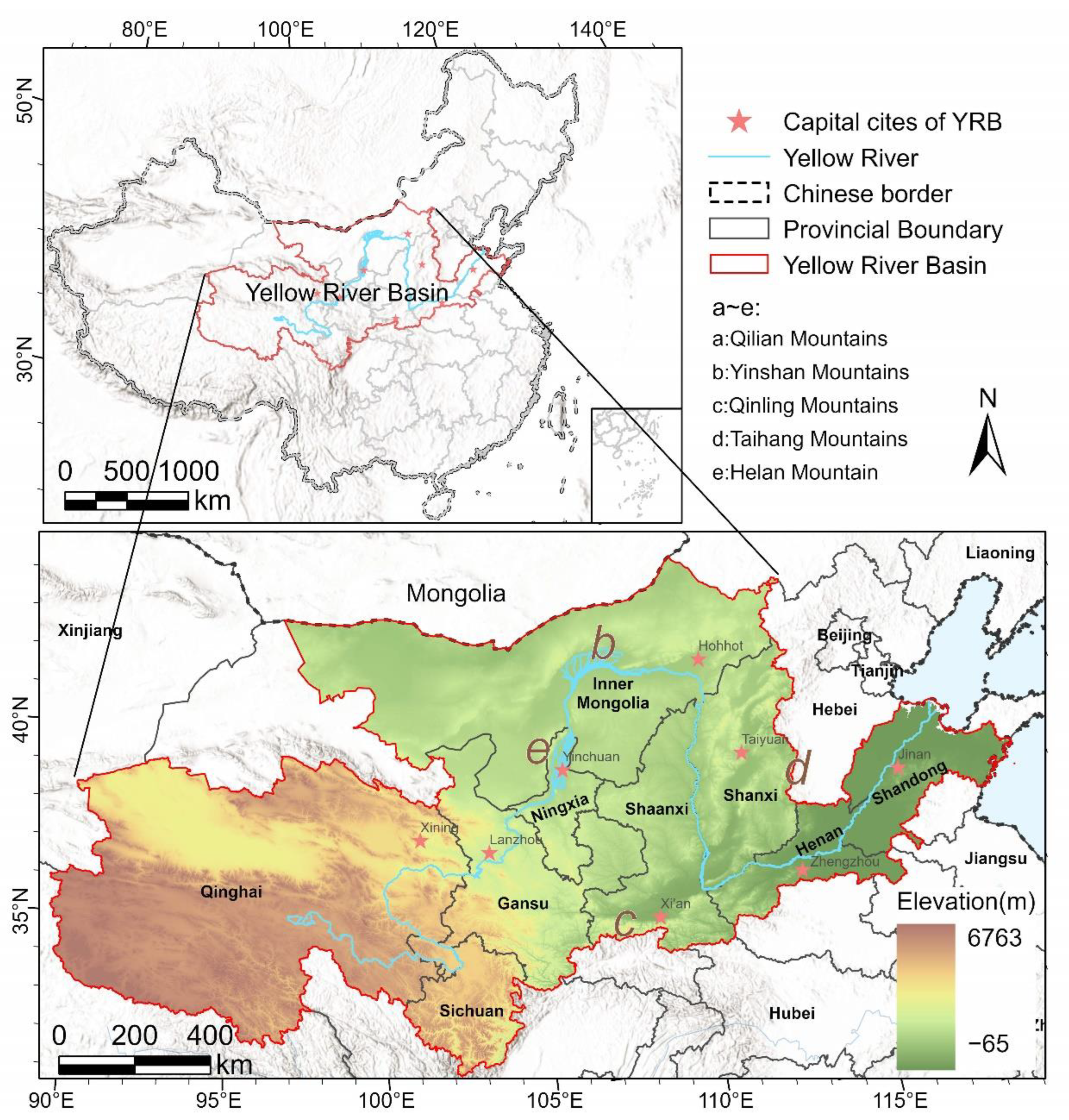

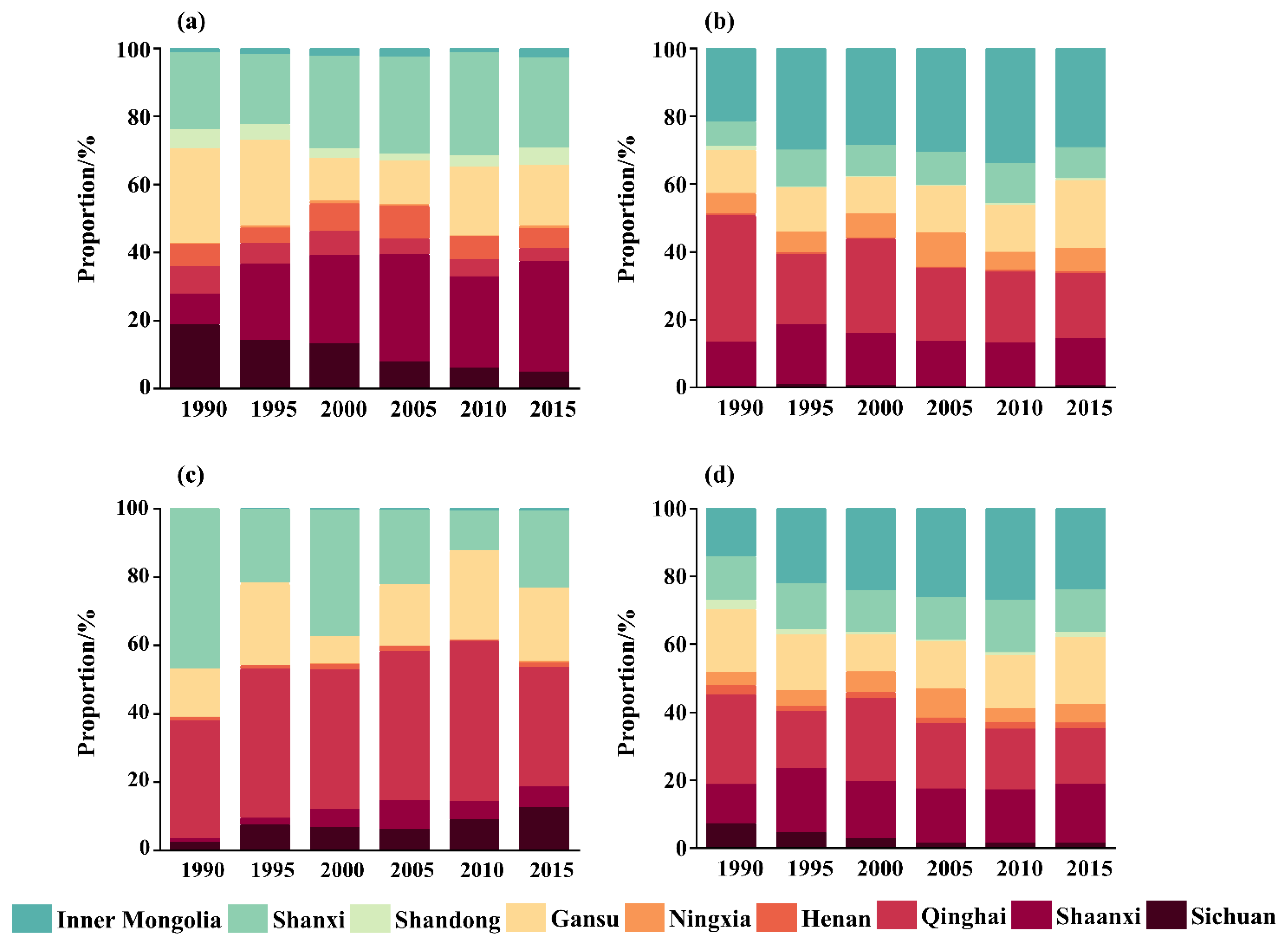
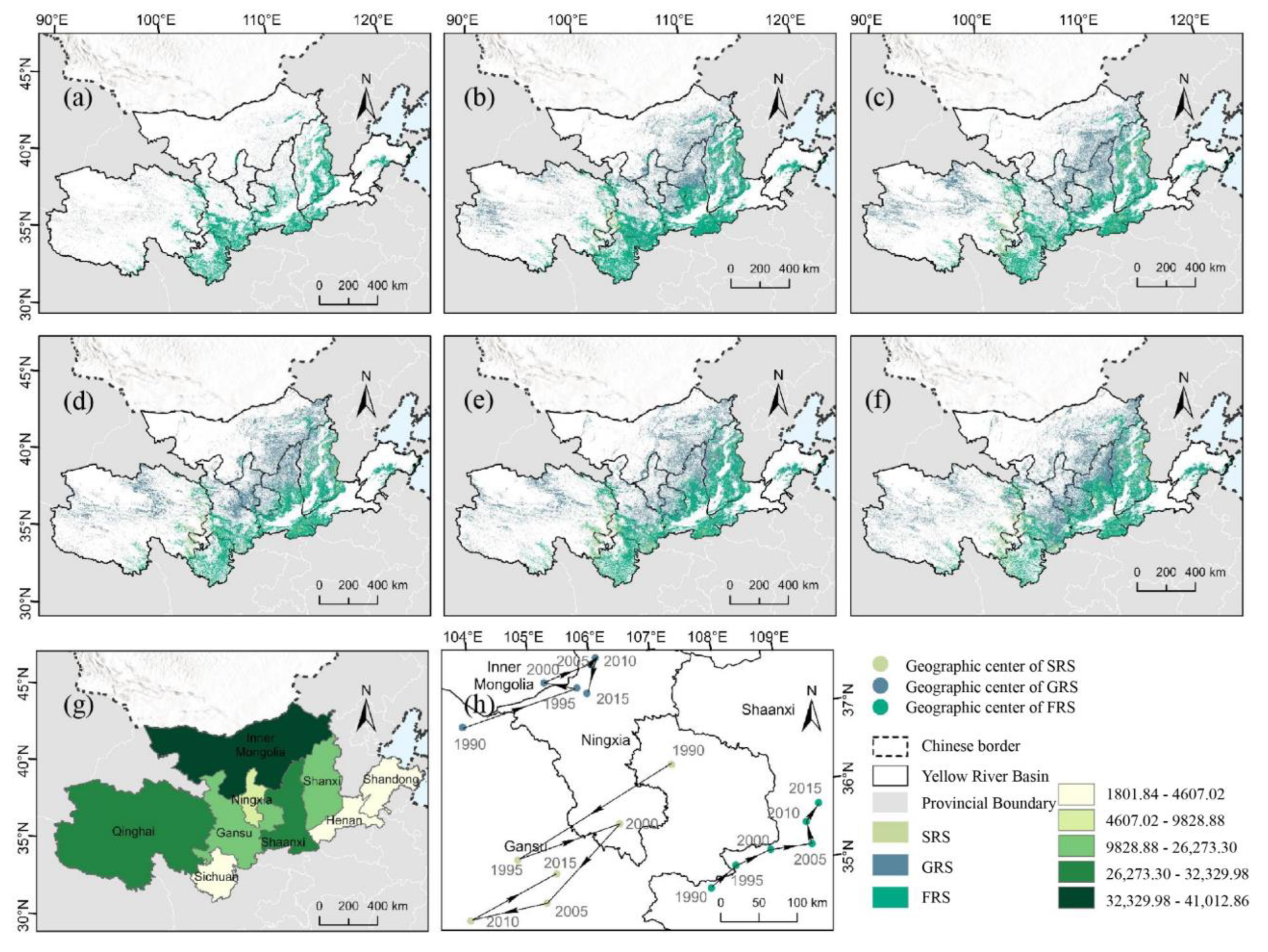
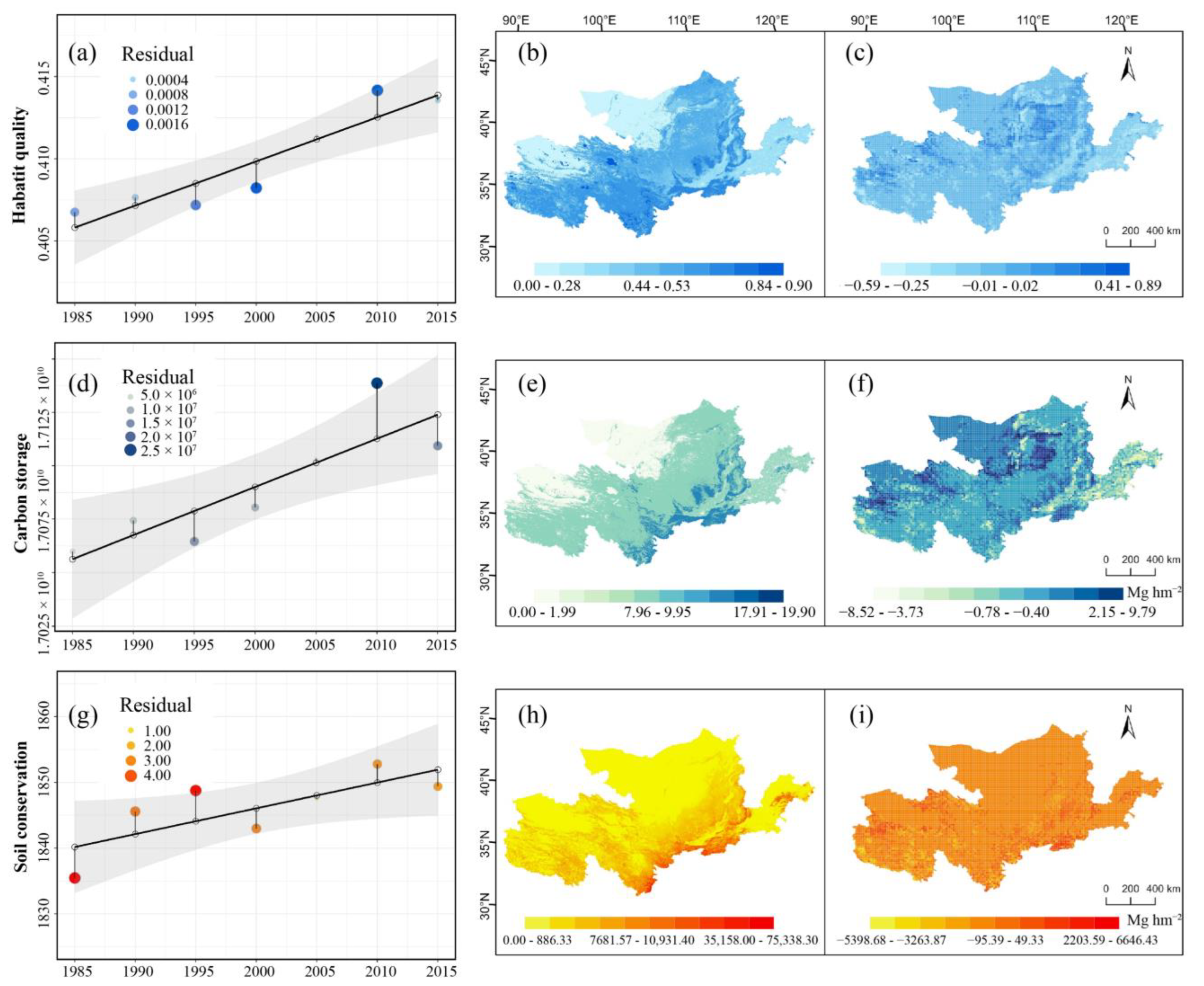

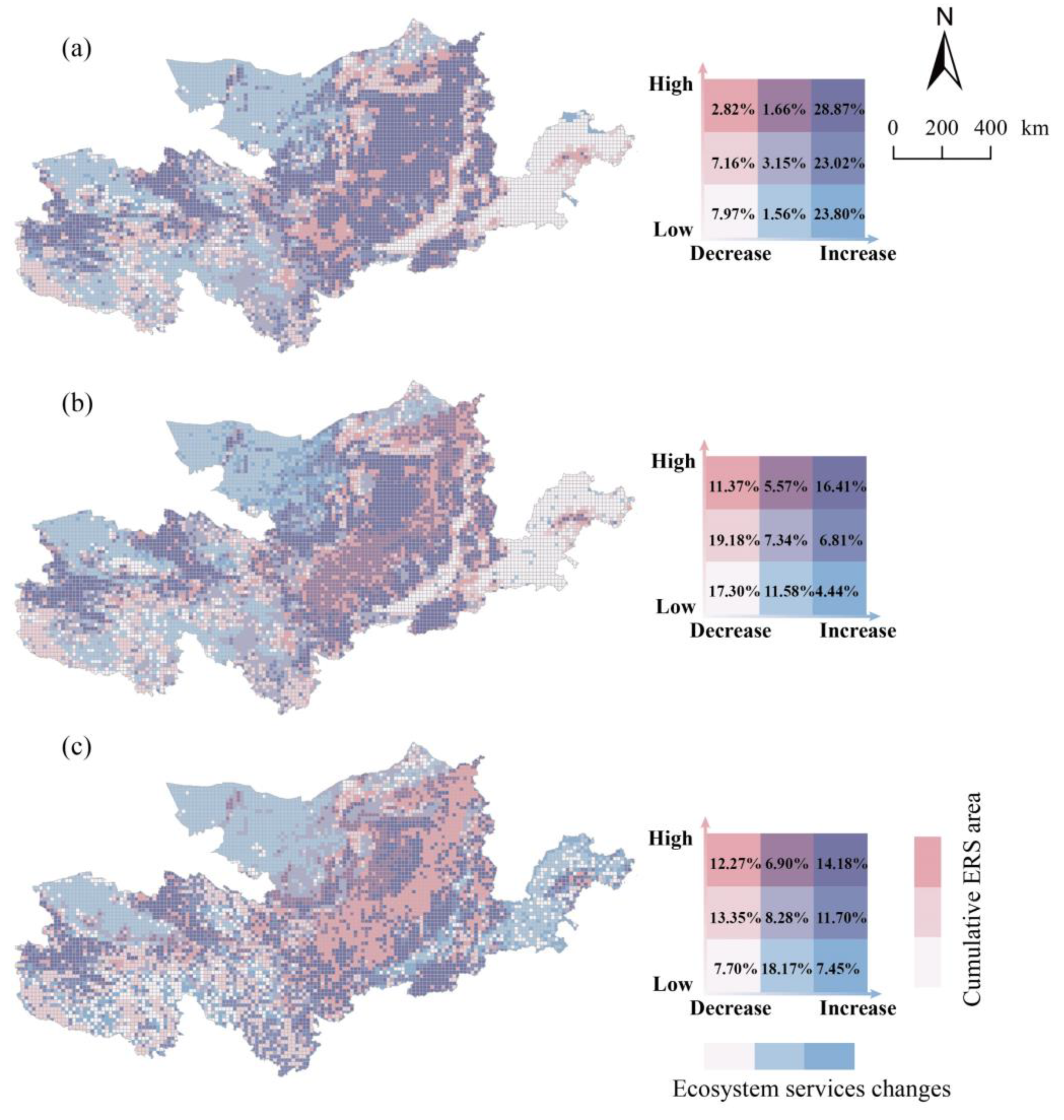
Disclaimer/Publisher’s Note: The statements, opinions and data contained in all publications are solely those of the individual author(s) and contributor(s) and not of MDPI and/or the editor(s). MDPI and/or the editor(s) disclaim responsibility for any injury to people or property resulting from any ideas, methods, instructions or products referred to in the content. |
© 2023 by the authors. Licensee MDPI, Basel, Switzerland. This article is an open access article distributed under the terms and conditions of the Creative Commons Attribution (CC BY) license (https://creativecommons.org/licenses/by/4.0/).
Share and Cite
Zhang, Y.; Hu, Z.; Han, J.; Liu, X.; Feng, Z.; Zhang, X. Spatiotemporal Relationship between Ecological Restoration Space and Ecosystem Services in the Yellow River Basin, China. Land 2023, 12, 730. https://doi.org/10.3390/land12040730
Zhang Y, Hu Z, Han J, Liu X, Feng Z, Zhang X. Spatiotemporal Relationship between Ecological Restoration Space and Ecosystem Services in the Yellow River Basin, China. Land. 2023; 12(4):730. https://doi.org/10.3390/land12040730
Chicago/Turabian StyleZhang, Yuhang, Zhenqi Hu, Jiazheng Han, Xizhao Liu, Zhanjie Feng, and Xi Zhang. 2023. "Spatiotemporal Relationship between Ecological Restoration Space and Ecosystem Services in the Yellow River Basin, China" Land 12, no. 4: 730. https://doi.org/10.3390/land12040730
APA StyleZhang, Y., Hu, Z., Han, J., Liu, X., Feng, Z., & Zhang, X. (2023). Spatiotemporal Relationship between Ecological Restoration Space and Ecosystem Services in the Yellow River Basin, China. Land, 12(4), 730. https://doi.org/10.3390/land12040730





